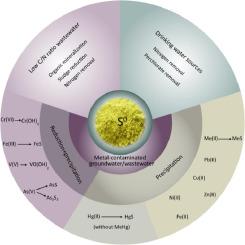Water Research ( IF 11.4 ) Pub Date : 2021-06-17 , DOI: 10.1016/j.watres.2021.117373 Liang Zhang 1 , Yan-Ying Qiu 2 , Yan Zhou 3 , Guang-Hao Chen 4 , Mark C M van Loosdrecht 5 , Feng Jiang 2

|
Biochemical oxidation and reduction are the principle of biological water and wastewater treatment, in which electron donor and/or acceptor shall be provided. Elemental sulfur (S0) as a non-toxic and easily available material with low price, possesses both reductive and oxidative characteristics, suggesting that it is a suitable material for water and wastewater treatment. Recent advanced understanding of S0-respiring microorganisms and their metabolism further stimulated the development of S0-based technologies. As such, S0-based biotechnologies have emerged as cost-effective and attractive alternatives to conventional biological methods for water and wastewater treatment. For instance, S0-driven autotrophic denitrification substantially lower the operational cost for nitrogen removal from water and wastewater, compared to the conventional process with exogenous carbon source supplementation. The introduction of S0 can also avoid secondary pollution commonly caused by overdose of organic carbon. S0 reduction processes cost-effectively mineralize organic matter with low sludge production. Biological sulfide production using S0 as electron acceptor is also an attractive technology for metal-laden wastewater treatment, e.g. acid mine drainage. This paper outlines an overview of the fundamentals, characteristics and advances of the S0-based biotechnologies and highlights the functional S0-related microorganisms. In particular, the mechanisms of microorganisms accessing insoluble S0 and feasibility to improve S0 bio-utilization efficiency are critically discussed. Additionally, the research knowledge gaps, current process limitations, and required further developments are identified and discussed.
中文翻译:

元素硫作为电子供体和/或受体:生物水和废水处理的机理、应用和前景
生化氧化和还原是生物水和废水处理的原理,其中应提供电子供体和/或受体。元素硫(S 0)作为一种无毒、易得且价格低廉的材料,兼具还原性和氧化性,是一种适用于水和废水处理的材料。最近对 S 0呼吸微生物及其代谢的深入了解进一步刺激了基于S 0的技术的发展。因此,基于S 0的生物技术已成为用于水和废水处理的传统生物方法的具有成本效益且有吸引力的替代方案。例如,S 0与补充外源碳源的传统工艺相比,自养反硝化大大降低了从水和废水中脱氮的运营成本。S 0的引入还可以避免通常由有机碳过量引起的二次污染。S 0还原工艺以低污泥产量经济高效地矿化有机物。使用 S 0作为电子受体的生物硫化物生产也是含金属废水处理(例如酸性矿山排水)的一项有吸引力的技术。本文概述了基于S 0的生物技术的基本原理、特征和进展,并重点介绍了功能性 S 0-相关微生物。特别是,微生物获得不溶性 S 0的机制和提高 S 0生物利用效率的可行性进行了批判性讨论。此外,还确定并讨论了研究知识差距、当前工艺限制和所需的进一步发展。











































 京公网安备 11010802027423号
京公网安备 11010802027423号